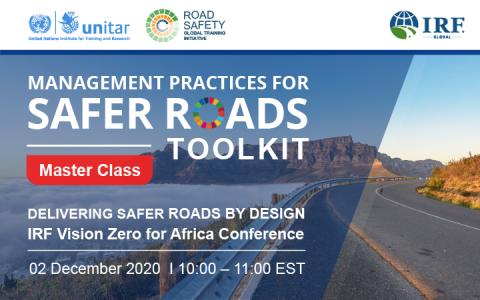
UNITAR Online Catalogue
Master Class: Management Practices for Safer Roads Toolkit

人类
背景信息
Road traffic injuries claim more than 1.35 million lives each year with a disproportionate impact on health and development. They are the ninth leading cause of death across all age groups globally and the leading cause among young people aged between 5 and 29 years. Nearly 3,700 people die on the world’s roads every day. More than half of the global traffic deaths are amongst pedestrians, cyclists and motorcyclists (WHO, 2018).
The 2030 Agenda for Sustainable Development set a goal of reducing road traffic deaths and injuries by 50% by 2020. Road Safety is included in the following Sustainable Development Goals (SDGs) and targets: SDGs 3, 11, 11.2.
Achieving road safety targets requires, among others, improving existing road infrastructure for the benefit of all road users, especially the most vulnerable (Decade of Action for Road Safety 2011-2020 – Pillar 2).
Improvements in infrastructure planning, design and construction, including the provision of safe infrastructure for pedestrians and cyclists can reduce the risks that lead to road traffic injuries and fatalities. A lack of basic facilities such as footpaths, cycle paths, crosswalks, motorcycle lanes and safe speed-controlled crossing points on many roads, increases the level of risk for all road users.
According to the World Health Organization, improving the 10% highest-risk roads in each country over 20 years, through the implementation of footpaths, safety barriers, bicycle lanes and paved shoulders, just to mention a few, has the potential to prevent around 3.6 million deaths and 40 million serious injuries (WHO, 2015).
Pillar 2 of the Road Safety Decade of Action highlights that providing safer roads also requires:
- Identifying the number and location of deaths and injuries by road user type, and the key infrastructure factors that influence risk for each user group
- Identifying hazardous road locations or sections where excessive numbers or severity of crashes occur
- Conducting safety assessments of existing road infrastructure and implement proven engineering treatments to improve safety performance
活动目标
In line with the Road Safety Decade of Action, the Toolkit overall objective is to serve as a guiding document of concrete measures that improve road safety by providing a methodology that identifies:
- The number and location of deaths and injuries by road user type, and the key infrastructure factors that influence risk;
- Hazardous road locations or sections where excessive numbers or severity of crashes occur and take corrective measures, accordingly.
内容和框架
The 1-hour conference facilitates a space to present the Management Practices for Safer Roads Toolkit and the experience in South Africa. This multi-stakeholder endeavor gathers the representation of senior government authorities, and representatives and executives from the private sector.
The structure of the event consists of introduction, presentation of the Toolkit, implementation in South Africa and call for expressions of interest.
目标受众
The Toolkit aims to serve government officials, policy makers, engineers, planners and practitioners, road safety professionals and road users in general.
更多信息
The toolkit is available for Desktop, and as a Mobile App.
Desktop: www.unitar.org/safer_roads_toolkit
Mobile App: www.unitar.org/srtapp